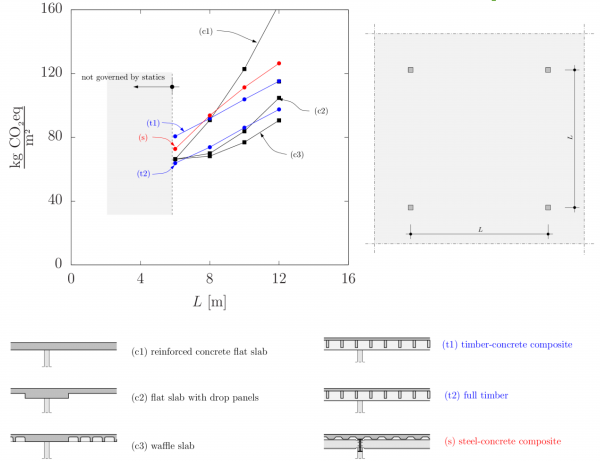Project - RecycleSlab
Summary
Within the scope of the seismic response of reinforced concrete structures, the goal of this project is to study the response of flat slab floors with drop panels at a large scale (representative of real structures), made with concrete with coarse recycled concrete aggregate (CRCAC), under combined gravity and lateral loads, to develop a Seismic European Code regulation for such structures. It will be the world’s first pseudo-dynamic and cyclic tests on CRCAC flat slabs and methodologies for safety checking will be proposed for implementation in design codes.
Testing a drop panels solution is aligned to the UN’s sustainable development goals, particularly for the reduction of material consumption and the associated CO2-eq production. In the last decades, the dominant structural typology with respect to buildings and parking garages has been flat slabs in ordinary concrete. Despite its architectural advantages due to a flat soffit, the material consumption of this type of structure is highly inefficient and is thus associated to a non-justified environmental impact. This is shown in Figure 1, which compares the kg of CO2-eq/m2 of floor area of 6 slab typologies. For moderate to large spans, the flat slab solution (curve c1) is highly inefficient, while drop panels (curve c2) present much lower impacts but have a comparable economic and social performance. Such difference in environmental impact is due to structural efficiency (material only arranged where needed). Figure 1 shows that reinforced concrete structures have similar, or better, environmental impact than timber or steel when the material is used in a sound manner.

Figure 1 – Analysis of CO2-eq per unit of built surface for different structural solutions (adapted from Regulez et al. 2022)
This is the case of flat slabs, a common and resource-efficient structural solution. Slabs are the main portion of the total concrete volume used in a building and are a prime candidate for structural CRCAC. However, there are few studies on the punching behaviour of flat slabs made with CRCAC under gravity loading, hindering the practical use of CRCAC. Furthermore, no studies exist on the seismic behaviour of CRCAC flat slabs, which is a subject of special importance in moderate to intense seismic areas. Unsatisfactory knowledge about the behaviour of CRCAC flat slabs under gravity loading and, especially, seismic actions, and lack of demonstrative example are obstacles to a larger use of CRCAC, justifying the need for research on this subject.
Flat slabs seismic response can be satisfactory, in combination with a primary wall or frame system to limit P-delta effects and damage to non-structural infills (Fardis, 2021). Seismic regulations in Europe for flat slab structures are still being developed (Fardis, 2021), with new provisions in the draft Eurocode 8. Application to these in the design of a large-scale test is an important verification A further relevant aspect is the study of the detailing for corner and edge connection. Previous tests showed the importance of these (Coronelli et al. 2021), while seismic design rules and European code specifications are required.
Since the motivation of the project is the analysis and demonstration of structural-and resource-efficient flat slab system, an environmental analysis will be carried out through comparative life cycle assessment (LCA). This LCA will compare the environmental impacts of the production of the prototype to be tested (made with CRCAC and drop panels) with that of a conventional flat slab system designed with similar structural behaviour. Therefore, the comparison will be made for a truly equivalent functional unit (the reference unit used for comparative LCA), instead of the typical functional units used in LCA studies on CRCAC (1 m3 of concrete, 1 MPa of compressive strength, and others), which are not fair since they do not cover the full implications of the incorporation of CRCA on structural design. This LCA will be used to quantify the potential reduction of the carbon footprint of the flat slab system associated with the use of drop panels and recycled aggregates.
The research is focused on the safety of people, on the economy and sustainability of the construction industry and is developed within the scope of ERIES Research Goal 1: Loss-driven design and mitigation approaches (seismic hazard), Goal 2: Risk quantification and prioritization (seismic hazard) and Goal 3: Green and sustainable development (see section 3.4). It is also in full agreement with the European Green Deal, the EU Circular Economy Action Plan, and the strategies of the cement and concrete industries for the reduction of their environmental impacts - e.g. recycled aggregate concrete is specifically stated as a means towards lower impact concrete in the CEMBUREAU Roadmap towards climate neutrality by 2050.
References
[1] Coronelli, D., Lamperti Tornaghi, M., Martinelli, L., Molina, F. J., Muttoni, A., Pascu, I., Pegon, P., Peroni, M., Ramos, A., Tsionis, G., Netti, T., (2021). Testing of a full-scale flat slab building for gravity and lateral loads, Engineering Structures, Volume 243, 2021,112551, ISSN 0141-0296.
[2] Fardis, M., N. (2021) “Flat slabs as primary seismic elements in second‑generation Eurocode 8” Bulletin of Earthquake Engineering.
[3] Regulez Pérez, B., Faria, D.V., Todisco, L., Fernández Ruiz, M., Corres Peiretti, H., (2022), Sustainability in construction: the urgent need for a new ethics, Structural Concrete, Wiley, accepted for publication.
